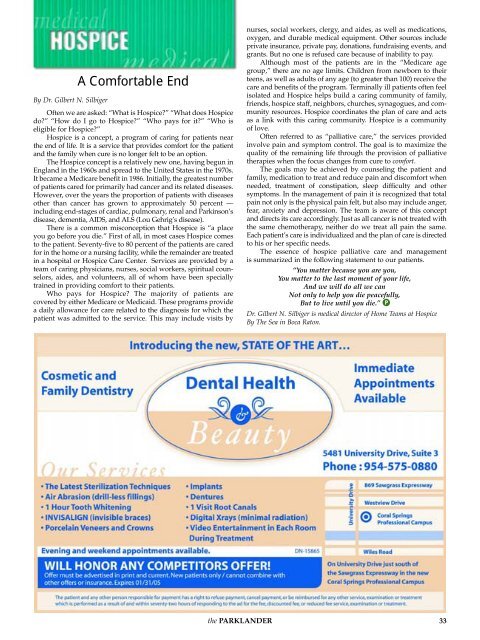Cover_Jan 05 (Page 2) - The Parklander Magazine
Cover_Jan 05 (Page 2) - The Parklander Magazine
Cover_Jan 05 (Page 2) - The Parklander Magazine
- No tags were found...
You also want an ePaper? Increase the reach of your titles
YUMPU automatically turns print PDFs into web optimized ePapers that Google loves.
A Comfortable End<br />
By Dr. Gilbert N. Silbiger<br />
Often we are asked: “What is Hospice” “What does Hospice<br />
do” “How do I go to Hospice” “Who pays for it” “Who is<br />
eligible for Hospice”<br />
Hospice is a concept, a program of caring for patients near<br />
the end of life. It is a service that provides comfort for the patient<br />
and the family when cure is no longer felt to be an option.<br />
<strong>The</strong> Hospice concept is a relatively new one, having begun in<br />
England in the 1960s and spread to the United States in the 1970s.<br />
It became a Medicare benefit in 1986. Initially, the greatest number<br />
of patients cared for primarily had cancer and its related diseases.<br />
However, over the years the proportion of patients with diseases<br />
other than cancer has grown to approximately 50 percent —<br />
including end-stages of cardiac, pulmonary, renal and Parkinson’s<br />
disease, dementia, AIDS, and ALS (Lou Gehrig’s disease).<br />
<strong>The</strong>re is a common misconception that Hospice is “a place<br />
you go before you die.” First of all, in most cases Hospice comes<br />
to the patient. Seventy-five to 80 percent of the patients are cared<br />
for in the home or a nursing facility, while the remainder are treated<br />
in a hospital or Hospice Care Center. Services are provided by a<br />
team of caring physicians, nurses, social workers, spiritual counselors,<br />
aides, and volunteers, all of whom have been specially<br />
trained in providing comfort to their patients.<br />
Who pays for Hospice <strong>The</strong> majority of patients are<br />
covered by either Medicare or Medicaid. <strong>The</strong>se programs provide<br />
a daily allowance for care related to the diagnosis for which the<br />
patient was admitted to the service. This may include visits by<br />
nurses, social workers, clergy, and aides, as well as medications,<br />
oxygen, and durable medical equipment. Other sources include<br />
private insurance, private pay, donations, fundraising events, and<br />
grants. But no one is refused care because of inability to pay.<br />
Although most of the patients are in the “Medicare age<br />
group,” there are no age limits. Children from newborn to their<br />
teens, as well as adults of any age (to greater than 100) receive the<br />
care and benefits of the program. Terminally ill patients often feel<br />
isolated and Hospice helps build a caring community of family,<br />
friends, hospice staff, neighbors, churches, synagogues, and community<br />
resources. Hospice coordinates the plan of care and acts<br />
as a link with this caring community. Hospice is a community<br />
of love.<br />
Often referred to as “palliative care,” the services provided<br />
involve pain and symptom control. <strong>The</strong> goal is to maximize the<br />
quality of the remaining life through the provision of palliative<br />
therapies when the focus changes from cure to comfort.<br />
<strong>The</strong> goals may be achieved by counseling the patient and<br />
family, medication to treat and reduce pain and discomfort when<br />
needed, treatment of constipation, sleep difficulty and other<br />
symptoms. In the management of pain it is recognized that total<br />
pain not only is the physical pain felt, but also may include anger,<br />
fear, anxiety and depression. <strong>The</strong> team is aware of this concept<br />
and directs its care accordingly. Just as all cancer is not treated with<br />
the same chemotherapy, neither do we treat all pain the same.<br />
Each patient’s care is individualized and the plan of care is directed<br />
to his or her specific needs.<br />
<strong>The</strong> essence of hospice palliative care and management<br />
is summarized in the following statement to our patients.<br />
“You matter because you are you,<br />
You matter to the last moment of your life,<br />
And we will do all we can<br />
Not only to help you die peacefully,<br />
But to live until you die.” ●P<br />
Dr. Gilbert N. Silbiger is medical director of Home Teams at Hospice<br />
By <strong>The</strong> Sea in Boca Raton.<br />
the PARKLANDER 33
















